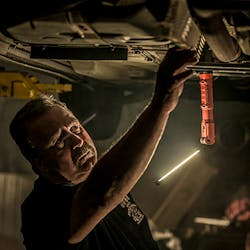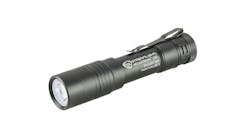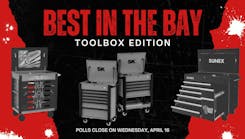One of the most basic necessities for technicians working in a shop environment is adequate lighting. Most importantly, proper lighting makes the workspace safer. Technicians who can see the space they’re in are less likely to trip over a pneumatic air hose or bump their head on a component protruding from a vehicle on a lift overhead.
Additionally, lighting also helps technicians work more efficiently. Primary shop lighting often comes from overhead ceiling lights, says Ullman Devices’ Director of Marketing, Mike Barthel. “Then, you possibly have the hood of the car open, and your own body casting a shadow ... sometimes ambient lighting isn’t going help you find what you’re looking for.”
Workspace lighting helps by providing brighter light in the specific areas technicians need to see. Personal workspace lights come in many forms, but are generally small and portable, such as a pocket flashlight or a headlamp. They allow technicians to focus light on specific areas they need to see in order to make a repair.
Out with the old...
Until fairly recently, workspace lighting was largely found in two forms: trouble lights (also known as service lights, drop lights, or inspection lamps) and worklights. Trouble lights traditionally consisted of an incandescent bulb at the end of a cord with a metal or plastic shade to prevent the bulb from touching anything or being broken.
“Worklights … used to be traditional halogen lights which got very hot,” says David Brands, president and CEO of Coast Products. “They were easily breakable. You put them up on a tripod and you lit up an area you were working in, and it would take a total of probably six square feet of space to put that light in. And then, you'd have to move it every time you moved.”
These products did provide adequate light, but they also had their drawbacks. Both types got very hot quickly, so a technician who accidentally touched the metal or glass surrounding the bulb would get burned. Incandescent and halogen bulbs have a relatively short lifespan, especially when bumped around in a work environment, so replacement was a common frustration. They also broke easily, so even a short drop would shatter the bulb.
“As soon as the tech dropped a light, it broke,” says John Schira, director of business development for Maxxeon. “Techs would get frustrated because they'd trip over the cord, or it would get chewed up in the fan or all kinds of reasons.”
Between the excessive heat from the incandescent or halogen bulbs, the frequent bulb replacement, the fragile nature of glass, the short bulb life, and the inconvenience of running a cord across the room, traditional worklights needed some improvements.
...In with the new
Light emitting diodes, or LEDs, changed all of that. For one thing, LEDs remain cool no matter how long they are switched on. For another, they are virtually indestructible.
“We've done tests, and the only way we've been able to break an LED, we found, was to take a center punch and line it up with the LED and hammer it,” Maxxeon’s Schira says.
LEDs also use a fraction of the energy compared to traditional bulbs. According to Coast’s Brands, they run on about 10 percent of the energy that it takes to operate a halogen or a traditional incandescent light. This makes LEDs the perfect candidate to run on battery power instead of needing to be plugged in, allowing them to be cordless.
“One of the biggest trends in flashlight technology is cordless USB rechargeable products, offering a quick, easy, and convenient way to recharge,” says Eric Pike, director of sales for Streamlight’s automotive/DIY division. “Professionals can simply connect to a USB port or an AC wall adaptor instead of being tethered to a charging base.
An extra benefit of using LED versus halogen and incandescent bulbs is that they can output far greater brightness, which is measured in lumens. Lumens are defined as a unit of luminous flux equal to the light emitted in a unit solid angle by a uniform point source of one candle intensity. LED workspace lights today are available well over 2,000 lm, whereas a standard 60W incandescent bulb is about 800 lm. Light output isn’t everything, however.
Quality over lumens
When LEDs first came on the scene, lumens were an exciting selling point. Products with the highest lumens were seen as being the best and brightest - literally. While they are technically the brightest, it is now becoming more well known that the brightest light isn’t the only quality to look for. It’s how the light is delivered that really counts.
“A lot of people get excited about how many lumens a light is,” Coast’s Brands says. “Depending on your work, that can be important, but for technicians who - most of their work is being done within four to eight feet - it's more the quality of the light beam rather than the brightness.”
Brands notes that Coast puts multiple light level settings in their lights so that technicians can set it to high, medium, or low, depending on how close the work they are doing is to the light source. He says that gives them the right amount of light they need, and also allows the technician to get up to 17 hours of light on one set of batteries.
“Our flood-beams are 95 percent consistent within the beam of light so that you don't get any dark spots or rings,” Brands says. “So, when you're doing your work, you don't miss anything or you don't have some black holes where you can't see. It's a very consistent, broad beam of light.”
Making a connection
The use of LEDs has made workplace lighting cordless, smaller, and lighter. This, in turn, has allowed for different ways to connect the light to an object in the technician’s workspace for hands-free use. Whereas the older corded trouble lights had only a hook, and worklights had to sit on the floor or be mounted on a tripod, LED products use connecting mechanisms such as magnets, clamps, and various means of wearing the light on a technician’s person.
Magnetic
While some LED lights still use traditional hooks, many also offer magnets for attaching the flashlight to metal surfaces for task-specific lighting, says Streamlight’s Pike. This allows the technician to attach the product to something metal and direct the light to the area where it is needed.
Clamping
“It’s becoming more and more difficult to find steel to stick a magnet light to in certain applications,” says Ullman’s Barthel. “You go under a car ... it’s a lot of plastic now, a lot of parts are made out of aluminum, and the magnetic lights just don’t stick to them.”
The same goes for aviation and marine technicians, Barthel continues. A lot of the body is aluminum on planes, and many recreational boats have fiberglass hulls. “Magnets are great if you have steel surfaces to stick to, but if you still have a need for lighting in an environment of aluminum, plastic, et cetera, the clamp light is ideal for that.”
Lights can also be clamped to a creeper when working underneath a vehicle. Creepers are traditionally wood or plastic, so a magnet won’t stick. But a light with a clamp can be attached next to the technician’s head, giving them a light source that moves along as they do.
Wearable
Perhaps the most truly hands-free use of a light is in a wearable application, the most common being the headlamp. Designed with an elastic strap, these lights can be worn around the technician’s head or clipped onto a safety helmet or hard hat.
“Up until two, three, five years ago, a lot of technicians were still putting lights in their mouth or trying to put it on the brim of their cap or whatever, to put light where they really needed it so the light would follow them around,” Brands says. “But, of course, there are some inherent problems with that. Working with a light in your mouth is not very fun, and if you're always holding it in one hand, that means you only have one hand to work with.”
Another example of a wearable is E-Z Red’s NK10 Multi-Position LED Neck Light, which is designed to be worn around the technician’s neck. It features a light on each side the technician can position to illuminate the area they are working in.
Tips for selling lighting products
One of the keys to selling lighting products to your customers is making sure they are informed and know what to look for. Demonstrate for them the difference between high lumen brightness and quality of beam. Show them the different methods of attaching lights to their workspace or body. Explain the different features of each light in detail.
Coast’s Brands says the best thing to do is turn off the lights in a room and turn on some lighting products, and technicians will immediately see which one is best for them.
“We do this little demonstration where we'll turn on one of our lights with an inspection beam and compare it to somebody else's who just has a standard beam or no beam, and most people will think that our light is much brighter,” Brands says. “But it's not that it's brighter, it's just that it's a better quality and so you can see better with it. That's really what professionals are looking for.”
Maxxeon’s Schira recommends carrying a light in your shirt or jacket pocket when you go into a shop. This gives technicians an opportunity to notice it, or for you to come to the rescue when a technician is having trouble seeing something he or she is working on. You can pull it out and demonstrate how well it illuminates the workspace.
Also be sure to point out whether the lighting product uses a rechargeable battery pack or alkaline batteries. Some technicians will have a preference for one or the other, and some products, such as Coast’s FL75R headlamp, can use either.
Displaying the various functions of a multipurpose light can be another strong selling point. For example, the Streamlight Stinger Switchblade is a cordless light that has a rotating double-sided light bar that rotates 180 degrees to offer three lighting options: the white LEDs, high CRI LEDs with Color-Rite technology for wiring, painting, or detailing, and a UV LED for crack and leak detection.
With so many quality lighting options available, there is a light to suit the needs of virtually any technician. Be sure to stock a variety of lights and demonstrate the features of each to give your customers the tools they need to perform their job safely and efficiently.



